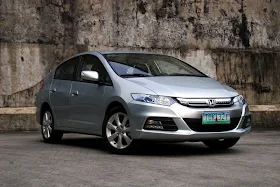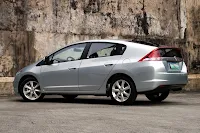 |
| Photos by Ulysses Ang |
Part of Honda’s goal with the Insight was to create a car that’s instantly recognizable as a hybrid. Although the general shape is reminiscent of another popular hybrid, the overall shape is largely dictated by the need to maximize efficiency by cutting wind resistance. Nonetheless, the Insight manages to sprinkle in some nifty design cues taken primarily from the company’s hydrogen fuel cell car, the FCX Clarity. Upfront, the twin-bar chrome grille and thin blue accent running into the bluish-tinged headlights give the Insight a unique eco car identity. The large air intakes, sharp roofline and 16-inch alloy wheels also contribute to make the Insight one sleek and sporty looking car.
Despite being a hybrid car, the Insight has a remarkably simple interior. Whereas other hybrids are confusing with their spaceship-like feel, the Insight is far more conventional. The dashboard design looks like a cross between the Civic and Jazz. The dual-level instrument cluster looks like it’s been lifted straight off the Civic’s with its digital speedometer visible above the steering wheel and tachometer and Eco Assist down below. Meanwhile, the center console and round vents would feel right at home in the Jazz. A great feature is the automatic climate control which is situated just to the right of the steering wheel allowing for excellent accessibility.
In terms of size, the Insight is actually 62 mm smaller than the Toyota Prius in both length and height, and also has a 152 mm shorter wheelbase. However, the net effect of this smaller interior volume is almost negligible as the Insight has ample room for four to five adults as well as luggage; a great packaging lesson learned from the Jazz.
Under the Insight’s hood is a drivetrain featuring Honda’s Integrated Motor Assist or IMA system. Doubters will point out that this system is a mere “mild” hybrid as opposed to a “full” hybrid (the Insight can’t move on battery power alone), but it’s less complex, less costly, and easier to package. The 1.3-liter SOHC i-VTEC motor is rated at 98 horsepower and 167 Nm of torque (from as low as 1,000 thanks to the on-board electric motor).
Aside from giving this car an interesting torque curve, the electric motor also assists in acceleration and steady state cruising at low to medium vehicle speeds. It acts as a generator during braking, steady cruising, gentle acceleration, and coasting to charge the battery. And finally, it also serves as the engine starter, quickly spinning the engine to idle speed after Auto Start/Stop and during normal vehicle starting.
From the get-go, Honda engineers wanted a hybrid that’s fun to drive, so they enlisted the help of another small gas-sipping car that meets that criteria: the Jazz. Although it doesn’t look it, the Insight borrows its entire front structure from the Jazz. Compared to the Honda sub-compact though, the rear axle has been moved back and the roof dropped. Occupants actually sit lower in the Insight resulting in a sportier, cozier feel. In addition, the supportive seats add to that feeling of sportiness with excellent bolstering. There are even paddle shifters behind the steering wheel which offer 7 pre-programmed ratios on the Insight’s CVT gearbox.
Immediately as the Insight moves, driver engagement is much more noticeable compared to other hybrids. Despite the lack of thrust, power delivery is linear and smooth. When crawling to a halt, the 1.3-liter motor dies and the battery takes over. Until of course, you let go of the brakes or step on the accelerator. The entire experience feels seamless; though the Insight tends to lurch for a couple of seconds as the gasoline motor comes to life when moving. On the open road, it’s a very enjoyable drive with the responsive steering wheel and tight handling. When needed, the Insight can utilize its paddle shifters for overtaking power. The shifts are surprisingly quick and seamless and in Sport mode, the Insight will hold the selected virtual gear until another ratio is selected, right up to redline. The only problem with the Insights is its brakes which feel too detached and bite too weakly. This is perhaps because it doubles as a means of energy recovery hence the lack of feel.
Like the Civic and CR-V, the Insight also provides visual feedback to coach drivers to be more fuel efficient. The background color of the digital speedometer gives a quick indicator by transitioning from blue (when driving aggressively) to green (when driving efficiently). Unlike the Civic and CR-V though, the Insight has a multitude of display options inside the tachometer which can be toggled via a steering wheel switch. The Insight also has Honda’s ECON button which modifies certain parameters to improve the fuel efficiency even more. With the ECON button on the entire week, but not being overly concerned about driving efficiently, the Insight still managed 17.44 km/L, but this figure can go up to 19.03 km/L on a short trip to Nuvali, Sta. Rosa.
Honda Cars Philippines has yet to announce whether the Insight would go on sale locally. They’re hoping to undercut its rivals when the government does deliver on its promise to give incentives to hybrid vehicles (it’s the cheapest hybrid for sale in the USA, after all). In the meantime, Honda has proven that it can create a car that can deliver outstanding fuel economy with enthusiastic handling the brand’s known for. The Honda Insight offers the best method approach to engineering and making a gasoline-electric hybrid vehicle and comes out, surprisingly, as a car enthusiast’s hybrid.























In a metropolis where traffic is as common as the bad air we breathe, it makes sense to drive a hybrid. I would like to drive one but I also need to know the cost of battery replacement and other associated maintenance costs. These cars have been in the U.S. for long and perhaps data are available for your readers.
ReplyDeleteThe alternative fuels and vehicles bill must be passed by Congress/Senate NOW!!!
ReplyDeletePlease! Honda 1st generation '99-'06 Insight came out before Toyota Prius. The first gen Insight was released in Japan in 1999, US markets in 2000. Get the facts right. The gen 1 Insight can go up to 150mpg or 63 KPL. Someone have already done 200 mpg on it. Car can be as snappy as an ordinary sedan or can go really slow. It's all up to the driver and his style. Don't mean to intrude at this BS post but I had to do it!
ReplyDelete